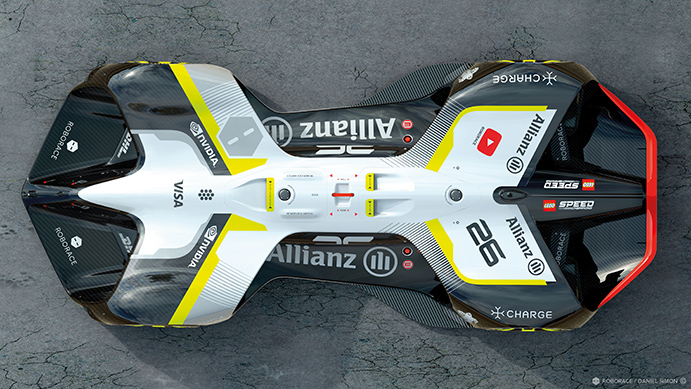Set to make its debut in the coming months on the Formula E undercard, Roborace will feature 200mph driverless cars autonomously controlled by artificial intelligence (AI). As with the Drone Racing League, all vehicles will be identical, but software engineers will compete with ‘AI Drivers’, where algorithms and feedback loops will replace human instinct and reaction speeds.

“The primary focus is on the ability of the AI Drivers to perceive and act within the dynamic environments that we create,” Roborace chief technical officer Bryn Balcombe explained.
“If an AI Driver is more accurate in perception it has a better chance of taking the correct actions.
“It’s the ground-based equivalent of a military dogfight with AI Drivers continually engaged in an OODA Loop [observe, orient, decide, and act]. The key challenge is to get inside the OODA loop of a competitor to gain an advantage.”
Feeding the big brain
Those feedback loops will be powered by the Nvidia Drive PX2, a processor capable of 24 trillion AI operations per second. Feeding that big brain will be a massive sensor suite made up of five lidar, two radar, 18 ultrasonic and two optical speed sensors, as well as six cameras and a GNSS module.
As for the Robocar itself, it’s been designed by Daniel Simon, the man behind the light cycles in Tron: Legacy, who has also worked with Bugatti and Lotus. It’s an incredibly striking vehicle that has already drawn much praise for its looks. But Roborace intends to thrill with substance, as well as style.
“Under the beautiful design, we have four independent electric motors,” said Balcombe. “That’s quite unique in motorsport and enables torque vectoring algorithms to be used in controlling the vehicle dynamics. With only a single throttle pedal, that level of control is not available to human drivers.
“We also expect more side-by-side racing manoeuvres given the cars have 360-degree real-time situational awareness of other objects. That exceeds the human’s current perception ability when relying purely on forward vision and a pair of wing mirrors.”
But personalities have always been an integral part of motorsport. The DRL has worked hard to portray its pilots as individual characters with different strengths and flying styles. While the Roborace action may well be incredible, will AI Drivers be able to capture the imagination in the same way that the icons of motorsport have?
Robots with charisma?
“It’s interesting to think about what we love about past and current racing legends,” said Balcombe. “It may be some time before Roborace AI Drivers have the off-track charisma of James Hunt. However, on-track personality is always defined by the driver’s actions and our own personal interpretation of intent, so there is no reason why we won’t see AI Drivers akin to Niki Lauda.”
It will be interesting to see how the different ‘personalities’ of the various AI Drivers shine through on the track. It’s hard to imagine a machine enjoying the same kind of adulation enjoyed by someone such as Ayrton Senna, but perhaps audiences will develop affinities for different AIs over time. In the meantime, Roborace will have to captivate in other ways. The absence of humans from the centre of the action presents an opportunity to push the broadcast boundaries.
“Roborace is truly unique in being able to combine the real and virtual worlds together,” said Balcombe. “That opens creative opportunities for the TV broadcast audience, the spectators at our events and the increasing market for gaming, AR and VR experiences.”





April 1886: the Brunkebergs tunnel
First ever example of a ground source heat pump?